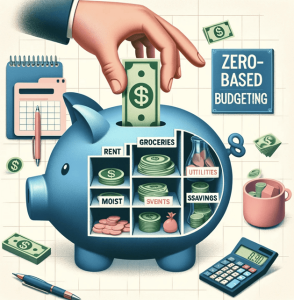Table of Contents
In the dynamic world of personal finance, Zero-Based Budgeting stands out as an effective method for managing finances. Unlike traditional budgeting methods, Zero-Based Budgeting (ZBB) begins each new budgeting period from a clean slate, where every dollar is accounted for and given a specific purpose.
This meticulous strategy transforms budgeting from a mere tracking tool into a proactive financial management plan. It empowers individuals to gain full control over their finances, ensuring that every financial decision aligns with their broader life goals and priorities.
To enhance this strategy, incorporating tools like a robust cashback app can add value by providing additional savings – like gas and food – on everyday purchases, which can then be reallocated to other budgeting categories or savings goals.
This approach ensures that your income minus your expenses equals zero, but not in the sense of leaving your bank account empty. Rather, it means that each dollar is intentionally allocated towards savings, expenses, or investments.
By integrating tools like cashback apps into your financial planning, you further optimize your budgeting process, ensuring every dollar is maximized to its fullest potential.
The Mechanics of Zero-Based Budgeting
- Balancing Act: Zero-based budgeting aims to ensure that your income minus your expenses equals zero. If you have money left over, it’s vital to allocate it wisely, perhaps towards debt repayment, savings, or investments, depending on your financial goals.
- Prioritization of Expenses: In Zero-Based Budgeting, prioritizing your expenses is key. Start by allocating funds to the most crucial categories, such as housing, food, and transportation, before moving on to less essential expenses. This ensures that your primary needs are always covered first, providing financial security.
- Expense Tracking: Continuously track your expenses throughout the month. This process involves accounting for every dollar spent and ensuring it aligns with your budgeted categories.
- Monthly Review and Adjustment: At the end of each month, review your expenses and income and prepare for the next month. This step is essential for adapting your budget to changing financial circumstances.
- Income Assessment: The first step involves thoroughly assessing your monthly income. This encompasses your regular paychecks and any additional income streams like side hustles or child support. Having an accurate total of what you’re working with each month is crucial.
- Expense Listing: Next, list all monthly expenses. This includes fixed costs like rent and utilities, variable expenses such as groceries, and discretionary spending. Don’t forget to factor in occasional expenses that may not occur monthly but impact your overall financial picture.
- Goal-Oriented Allocation: Every dollar in Zero-Based Budgeting should work towards a specific financial goal. Whether paying down debt, saving for a vacation, or investing in retirement, assigning your money to clear, defined objectives keeps you motivated and focused. It’s not just about balancing the books but about making your money work towards your personal and financial aspirations.

Advantages of Zero-Based Budgeting
Zero-based budgeting offers several advantages over traditional budgeting methods. It provides a clear and detailed view of where your money is going, thus encouraging more mindful spending. It also allows for greater flexibility, as you can adjust your budget monthly based on your current financial situation. Moreover, it’s an effective tool for achieving financial goals, whether debt reduction, saving for a major purchase, or investing for the future.
Practical Application of Zero-Based Budgeting
Let’s consider a practical example: Suppose you earn $7,000 monthly. After listing and summing all your expenses, savings contributions, and debt repayments, you allocate every dollar of that $7,000.
You might increase your savings contribution or pay down debt faster if you have extra funds. Conversely, if you’re overspending, you must adjust your budget to ensure your total spending doesn’t exceed your income.
The Digital Edge: Budgeting Tools
Various tools and apps can streamline the Zero-Based Budgeting process in today’s digital age. These tools automatically track your income and expenses, making it easier to stick to your budget and adjust as needed.
Zero-based budgeting is versatile and can be adapted to various income scenarios, including irregular income streams. In such cases, base your budget on the lowest expected income for the month and adjust as necessary when additional income is realized.
Conclusion: The Power of Every Dollar
Zero-based budgeting is more than just a method; it’s a mindset that emphasizes the power of every dollar. It requires discipline and regular monitoring but offers significant financial clarity and goal achievement rewards.
Whether navigating through debt, saving for a dream, or simply seeking better financial management, Zero-Based Budgeting provides a structured, goal-oriented approach to making every dollar count.


